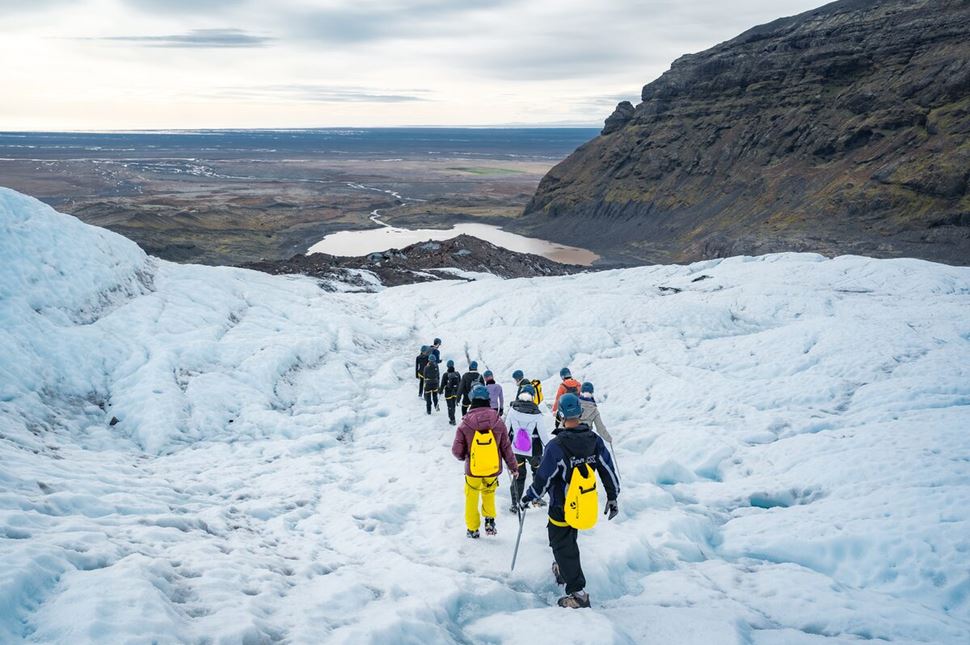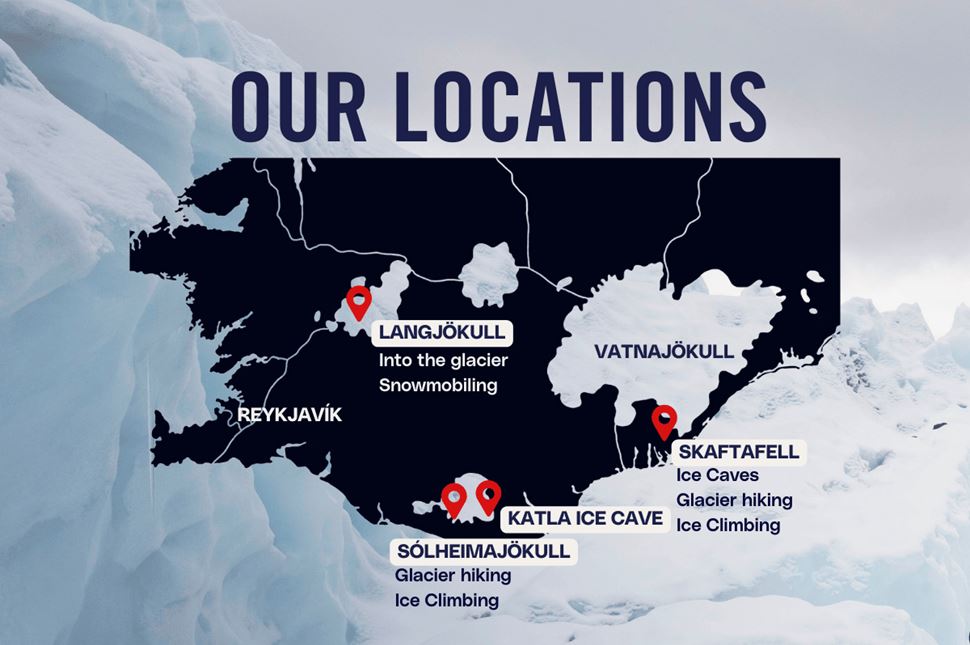Vatnajökull - Europe’s largest ice cap with at least 30 outlet glaciers.
Snæfellsjökull - stratovolcano mentioned in Jules Verne's novel “Journey to the Center of the Earth”.
Mýrdalsjökull - a glacier that covers Katla, one of Iceland's most active volcanoes.
Svínafellsjökull - a hot spot for filming, where Game of Thrones was filmed.
Sólheimajökull - an easily accessible outlet for hiking and ice-climbing.
Virkisjökull - an outlet that is being studied for climate change.
Breiðamerkurjökull - a glacial tongue known for its blue ice caves.
Langjökull - Iceland's second-largest ice cap, ideal for snowmobiling.
Eyjafjallajökull - ice cap resting on a volcano that erupted in 2010.
Eiríksjökull - Iceland's largest flat-topped volcanic glacier, "tuya."
Tindfjallajökull - glacier covering a collapsed volcano in Iceland's highlands.
Falljökull - the 'Falling Glacier' named for its fast-flowing ice.
Drangajökull - unique as the only ice cap in the Westfjords.
Hofsjökull - a glacier that hides a volcano and feeds major rivers in Iceland.
Iceland is world-famous for its colossal ice sheets, like Vatnajökull, the largest in Europe. At Arctic Adventures, we lead you to meet these ice giants up close.
Choose from our wide range of "meet on location" glacier tours or a convenient pick-up from Reykjavík. Hike, ice climb, or venture into tunnels and caves - whatever you choose, you’ll experience some of the most epic frozen landscapes on Earth.

Photo from one of our glacier hiking tours on Falljökull glacier, a tongue of Vatnajökull. Source: Arctic Adventures.
Iceland is 11% ice, and every glacier has its own story. Some hide volcanoes beneath the surface, while others feed icebergs into glacial lagoons. With our experienced guides who know these icy giants like the back of their hand, you can trek through surreal landscapes and take in views that are truly one of a kind.
If it’s your first time exploring glaciers, head south for two of the most famous ice walks. Every excursion feels different. On the Sólheimajökull Glacier hike, volcanic ash streaks across the snow, creating black-and-white patterns - like something from a sci-fi movie.
Further south, in Vatnajökull National Park, the Skaftafell Glacier hike takes you to mountain views, deep crevasses, moulins, and ridges. The landscape feels wide and open, with Iceland’s tallest peak towering in the distance. For something more exclusive, the Crevasse Labyrinth tour lets you walk between towering ice walls on a hidden trail few ever get to see.
And that’s just scratching the surface. You can even combine your glacier hike with a boat tour in a lagoon or horseback riding!
The Glaciers of Iceland are scattered across the island, each with its own unique scenery and origin. Near Reykjavik and the Golden Circle is the Langjökull or “Long Glacier”, with the Eiríksjökull glacier to the north. On the South Coast, some of the most accessible glaciers include Eyjafjallajökull, Mýrdalsjökull, and Sólheimajökull, all clustered together and easy to reach for visitors.
Further east along Route 1, you’ll find Vatnajökull and its popular outlets like the adventure lover’s paradise - Falljökull, Svínafellsjökull, and Breiðamerkurjökull, which feeds into the famous Jökulsárlón lagoon. Snæfellsjökull, a glacier-capped volcano located at the tip of the Snæfellsnes Peninsula, stands proudly in its namesake National Park. In the remote Westfjords, Drangajökull is the only glacier in the area.
No matter where you are in Iceland, you’re never too far from a glacier. Choose where to start!

Most of the glaciers can be found on the South Coast, including the majestic Vatnajökull, the volcanic glacier Eyjafjallajökull, Mýrdalsjökull, and many more. You can also see these icy wonders in areas like Westfjords, Snæfellsnes peninsula, and right outside Reykjavik.
Yes, glacier walking in Iceland is easily accessible and fun! However, it’s only allowed with an expert guide. They will keep you safe and enhance your experience by educating you on the area, taking you to various ice caves, or pointing out interesting formations.
The conditions on the ice can be harsh, so it’s crucial to wear the proper clothing for Iceland's climate—absolutely no jeans! Wear layers, thermal pants, a vest, a waterproof jacket, hiking boots, sunglasses, and other weather-appropriate attire. Ice crampons and helmets are also essential for safety, but don’t worry—we provide them on our tours.
In Iceland, the icy wonders all share the suffix “jökull,” which means glacier. What sets them apart is the beginning of their names. Some of the more famous names of ice caps include:
Interestingly, a glacier can lose its name. For instance, Okjökull has shrunk so much that it’s now called Ok.
You can see and enjoy glacier hiking and ice-climbing all year round. The only difference is that in summer, you won't be able to visit as many natural ice caves. However, in winter, the weather conditions can be harsh, which can also limit the opportunities for visitors.
The top glacier tours in Iceland include the Sólheimajökull Glacier Walk, perfect for beginners and close to Reykjavík, with an ice-climbing option for extra adventure. Vatnajökull Glacier Hike and Ice Caving that takes you deep into Europe’s largest glacier, with stunning blue crevasses and caves to explore. For thrill-seekers, the Langjökull Ice Tunnel & Snowmobiling tour combines snowmobiling with a walk through the world’s longest ice tunnel.
Yes, you can climb glaciers in Iceland. It is a fantastic addition to a hiking tour to popular sites such as Vatnajökull and Sólheimajökull. Experienced guides lead the way, and safety gear, including ice crampons and harnesses, is provided.
The two best and most easily reachable glaciers for ice climbing are Sólheimajökull, where our ice climbing adventure tour takes you on an action-filled experience, and Falljökull, the more challenging glacier hike.
Climbing an ice wall can be challenging. Before you try it, you should understand the simple basics. First, you need to learn how to use equipment like crampons, ice axes, and more. Second, you should know the best climbing technique - squatting, standing and swinging. On tour, our guides will help you master these skills step by step.
You can hike a glacier in Iceland without a guide, but it's a very unsafe choice. Ice masses can be dangerous, especially for non-professionals. It’s not just the hiking that’s risky. Unpredictable weather and local conditions can catch you off guard. Joining a guided tour is a smarter and safer way to explore.
An easy walk through Sólheimajökull typically takes around 1-2 hours, while more challenging hikes near Skaftafell can last 3-4 hours. Keep in mind these times don't include transfers, driving, or safety briefing, which adds to the overall trip duration. If you’re adding an ice climbing activity, you’ll spend even more time on the ice.
Sólheimajökull outlet is a top choice for glacier walking due to its proximity to the capital, Reykjavik. Vatnajökull National Park is another popular option for a more adventurous experience. However, it's important to note that not every ice cap is safe to go on, so always join guided tours for safety's sake.
The walk from the parking lot of Sólheimajökull Glacier to the ice takes just 15 minutes. However, it’s important to note that the drive from Reykjavík to the glacier's location takes over 2 hours and covers about 98 mi (158 km).
Yes, you should definitely dedicate a day to walking or hiking on a glacier in Iceland - it’s totally worth it! You don’t need any prior experience - beginners quickly pick up the technique of walking with crampons. Once you’ve got that down, you can really enjoy the stunning surroundings and the scenic hike.
The easiest glacier to see in Iceland is Sólheimajökull, an outlet of Mýrdalsjökull. It’s about a two-hour drive from Reykjavík, and you can even reach the car parking lot with your own vehicle. To get there, take Route 1 east, then follow the signs to Sólheimajökull.
Yes, you can see glaciers in Iceland during the summer. Hikes, walks, and climbing tours are available year-round, and summer is a great time for these activities since the ice is softer and the grip is better. Just keep in mind that glacial caves may have limited access during the summer due to melting.
|
|
|
|
|
|
Need more information or assistance? We are here to help!